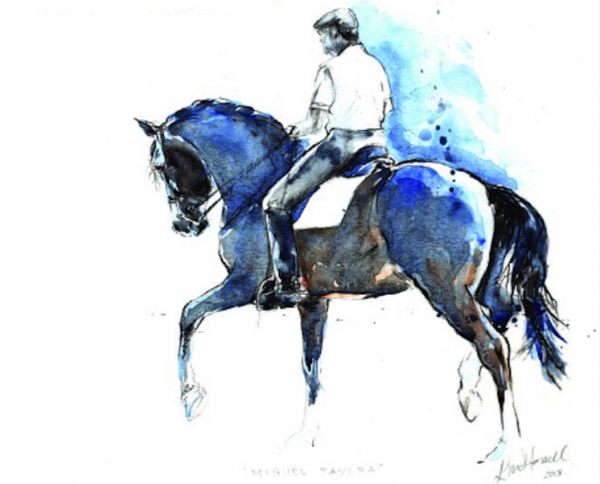
(© 2020 Kip Mistral. Images and excerpts used with permission of the publisher Xenophon Press.)
“The horse must always feel comfortable in all equestrian activities. This is how we show him our love and respect.”
I read books about classical training and riding techniques all the time (and have even co-authored one), but I find “Dressage Principles and Techniques” by renowned Portuguese classical dressage trainer Major Miguel Tavora, published by Xenophon Press in 2018, to be extraordinary.
It is extraordinary because this author is able to teach a complete, well-illustrated program of basic classical equitation and training in great detail, and combine high seriousness about the importance of classical method and technique with repeated reminders to treat the horse with understanding, kindness, love and respect…all this written in simple and easy-to-follow language, in only 158 pages. Those 158 pages will take you from terminology and theory to first longeing to work in-hand to canter pirouette, piaffe and passage. Finally, here is the thought-provoking yet very useful book you really can take to the barn.

An abbreviated background so you know your teacher’s pedigree. Born in Lisbon to the ninth Marquis and Marchioness of Abrantes, Major Miguel de Lancastre e Tavora (Abrantes) studied classical dressage with Nuno Oliveira from age eight to age eighteen. By fourteen Tavora had trained his first horse all the way to Grand Prix. I would call that precocious; however, one of the hallmarks of Tavora’s approach is humility. In one interview he claimed that compared to some of his naturally gifted colleagues that though he believed he had no such talent for riding, he was able to overcome the lack of inborn brilliance with his love and dedication to the horse and by leaving no stone unturned in his study and practice.
After this rather illustrious start in equitation Tavora made a career in the Portuguese military, competing in eventing, show jumping and dressage. He completed the Course of Instructors and Course of Masters at the Portuguese Military and Civilian Riding Academy of Mafra, where he was later appointed Chief Instructor and Director. Subsequent to his retirement he emigrated to Australia and spent the rest of his life teaching and coaching riders to high success.
“Dressage Principles and Techniques” is well subtitled “blueprint.” A blueprint is a schematic that shows a plan or model for creating something. The guidelines are provided for an extra-structure but not for the infrastructure. I am reminded that riding and training is an “inside” job, because though the book sets out a precise program of development of both horse and rider, there is plenty of white space for you and your horse to ask each other questions, experiment and communicate. In fact, almost every line is thought-provoking, sometimes deeply. For instance, the simple statement:
“Our first task is to secure the mental and physical relaxation of the horse.”
Well, who could argue with that point? But then the questions start coming quickly…what has had to come first before we can secure this relaxation? Our attitude, our approach, our friendship, our patience, our appreciation? And that is just the human component…there are dozens of questions to ask the horse as well.
Here’s another one:
“Contact must always bestow a feeling of harmonious communication with the horse, that the horse is happy and comfortable to have that connection with us.”
The first question that comes to mind is, looking around, how often do we see that kind of contact? Do we feel it ourselves?
Buy this book. While you’re experimenting with seeking collection, perfecting lateral movements and counter-canter and flying changes, keep the dialogue open between you and your horse. You’ll progressively become more and more aware of where you end and your horse begins, and vice versa, a space that can become a sanctuary for you both worth far more than any color of ribbon or trophy.
